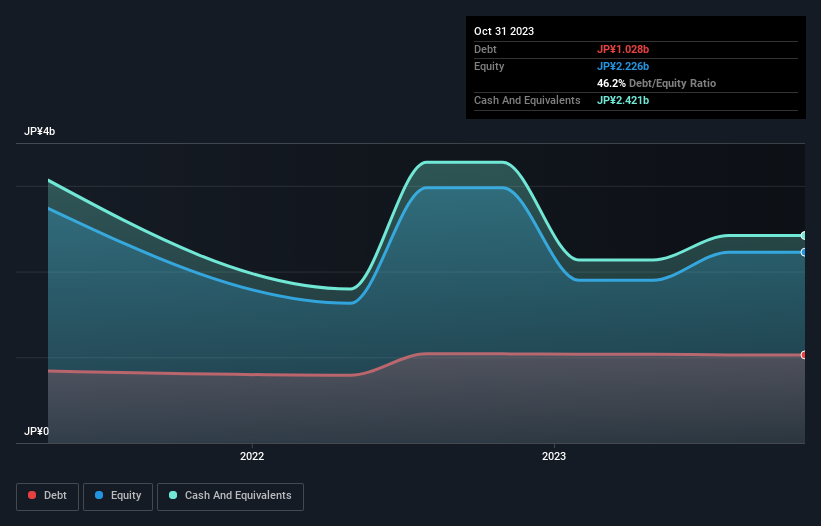- United States
- /
- Professional Services
- /
- NasdaqCM:PXDT
Does Pixie Dust Technologies (NASDAQ:PXDT) Have A Healthy Balance Sheet?
Legendary fund manager Li Lu (who Charlie Munger backed) once said, 'The biggest investment risk is not the volatility of prices, but whether you will suffer a permanent loss of capital.' It's only natural to consider a company's balance sheet when you examine how risky it is, since debt is often involved when a business collapses. As with many other companies Pixie Dust Technologies, Inc. (NASDAQ:PXDT) makes use of debt. But is this debt a concern to shareholders?
Why Does Debt Bring Risk?
Debt is a tool to help businesses grow, but if a business is incapable of paying off its lenders, then it exists at their mercy. Ultimately, if the company can't fulfill its legal obligations to repay debt, shareholders could walk away with nothing. However, a more usual (but still expensive) situation is where a company must dilute shareholders at a cheap share price simply to get debt under control. Having said that, the most common situation is where a company manages its debt reasonably well - and to its own advantage. When we think about a company's use of debt, we first look at cash and debt together.
See our latest analysis for Pixie Dust Technologies
How Much Debt Does Pixie Dust Technologies Carry?
As you can see below, Pixie Dust Technologies had JP¥1.03b of debt, at October 2023, which is about the same as the year before. You can click the chart for greater detail. But it also has JP¥2.42b in cash to offset that, meaning it has JP¥1.39b net cash.

A Look At Pixie Dust Technologies' Liabilities
Zooming in on the latest balance sheet data, we can see that Pixie Dust Technologies had liabilities of JP¥1.36b due within 12 months and liabilities of JP¥491.9m due beyond that. Offsetting these obligations, it had cash of JP¥2.42b as well as receivables valued at JP¥13.6m due within 12 months. So it actually has JP¥577.9m more liquid assets than total liabilities.
This short term liquidity is a sign that Pixie Dust Technologies could probably pay off its debt with ease, as its balance sheet is far from stretched. Succinctly put, Pixie Dust Technologies boasts net cash, so it's fair to say it does not have a heavy debt load! There's no doubt that we learn most about debt from the balance sheet. But it is Pixie Dust Technologies's earnings that will influence how the balance sheet holds up in the future. So when considering debt, it's definitely worth looking at the earnings trend. Click here for an interactive snapshot.
In the last year Pixie Dust Technologies wasn't profitable at an EBIT level, but managed to grow its revenue by 37%, to JP¥845m. Shareholders probably have their fingers crossed that it can grow its way to profits.
So How Risky Is Pixie Dust Technologies?
Statistically speaking companies that lose money are riskier than those that make money. And the fact is that over the last twelve months Pixie Dust Technologies lost money at the earnings before interest and tax (EBIT) line. And over the same period it saw negative free cash outflow of JP¥2.4b and booked a JP¥2.2b accounting loss. Given it only has net cash of JP¥1.39b, the company may need to raise more capital if it doesn't reach break-even soon. Pixie Dust Technologies's revenue growth shone bright over the last year, so it may well be in a position to turn a profit in due course. Pre-profit companies are often risky, but they can also offer great rewards. The balance sheet is clearly the area to focus on when you are analysing debt. But ultimately, every company can contain risks that exist outside of the balance sheet. These risks can be hard to spot. Every company has them, and we've spotted 2 warning signs for Pixie Dust Technologies (of which 1 is a bit unpleasant!) you should know about.
If, after all that, you're more interested in a fast growing company with a rock-solid balance sheet, then check out our list of net cash growth stocks without delay.
New: Manage All Your Stock Portfolios in One Place
We've created the ultimate portfolio companion for stock investors, and it's free.
• Connect an unlimited number of Portfolios and see your total in one currency
• Be alerted to new Warning Signs or Risks via email or mobile
• Track the Fair Value of your stocks
Have feedback on this article? Concerned about the content? Get in touch with us directly. Alternatively, email editorial-team (at) simplywallst.com.
This article by Simply Wall St is general in nature. We provide commentary based on historical data and analyst forecasts only using an unbiased methodology and our articles are not intended to be financial advice. It does not constitute a recommendation to buy or sell any stock, and does not take account of your objectives, or your financial situation. We aim to bring you long-term focused analysis driven by fundamental data. Note that our analysis may not factor in the latest price-sensitive company announcements or qualitative material. Simply Wall St has no position in any stocks mentioned.
About NasdaqCM:PXDT
Pixie Dust Technologies
Focuses on personal care and diversity, and workspace and digital transformation businesses primarily in Japan.
Slight with mediocre balance sheet.
Similar Companies
Market Insights
Community Narratives





